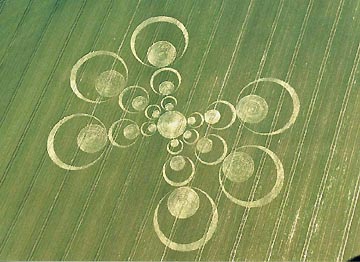
July 17, 2003 Howell, New Jersey After the Ogbourne St. George formation was discovered in Wiltshire, England, on Sunday, June 15, photographer and researcher Lucy Pringle wondered if it could be an 8-fold geometry instead of 6-fold? The reason is the “butterfly wing” distribution of the six arms, rather than an equally spaced distribution of the arms or spokes around the central circle. I was curious and asked professional land surveyor, Vincent Creevy, of Howell, New Jersey, to look at Lucy’s aerial photographs.
Interview:
Vincent Creevy, Professional Land Surveyor, Howell, New Jersey: “It’s my opinion that the formation is complete, that the intent of this was to make a series of spokes radiating out from the central circle and that they were to be based on the number three. There are three circles going out from the central circle there and each one of those “arms” is made up of three different circles. There is the small circle and then two intersecting circles that create a crescent and then they radiate getting progressively larger. You might want to take a look at that and see if there is a ratio of three in how they are getting larger. You might find there is something in there as well.
Also when you add up all the different radii, they equal 54, which is also divisible by 3. The central circle is in addition to the 54, but I think that’s the intersection point to lay these out on.
IS THREE A PRIME NUMBER?
Yes.
THAT MEANS?
It’s divisible only by itself, or one.
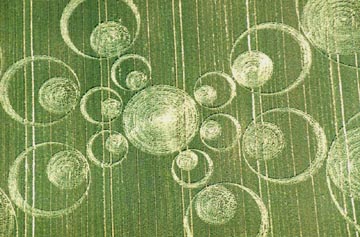
IF YOU WERE GOING TO TRY TO LAY THIS OUT AS A SURVEY PROJECT, IS THERE ANYTHING ABOUT THIS THAT WOULD BE ESPECIALLY DIFFICULT TO DO?
Probably not. It looks like everything is laid out at a right angle from the central point. You have four spokes that are out at 90 degrees. The other two come out bisecting that angle at 45 degrees. So, all of these things are laid out in a straight line. You would need 54 stakes or points of radii origin to lay these out and then once you’ve done that, it would probably take an hour or two in the office to calculate and then probably two to three hours to lay it out in the field. And then I don’t know how you would go about laying down the crop or how long that would take, because I’ve never tried anything like that.
ISN’T IT INTERESTING THAT THE BELGIUM FORMATION THIS YEAR IS SO SIMILAR TO THE JULY 25, 2001, GOG MAGOG HILLS ‘ANGEL?’ AND THE BELGIUM ONE HAS 54 RAYS INSTEAD OF 75 RAYS (IN 2001) AND THE CIRCLE SURROUNDED BY A CRESCENT IS A REPEATED PATTERN IN THE OGBOURNE ST. GEORGE FORMATION?
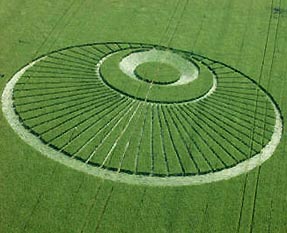
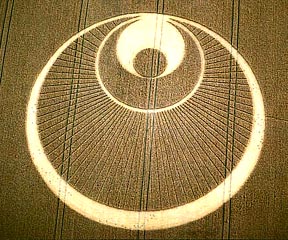
That is interesting and the circles themselves do seem to be set up essentially on the same kind of circle/crescent pattern in all of them. (the Ogbourne St. George and Belgium and July 25, 2001 Gog Magog Hills.)
The other thing that stands out is that if someone actually surveys this formation and measures it, you’re probably going to find other ratios of three, either in area of circles circumscribed there, or perhaps in the ratio of the radii among the circles.
SO IF WE WERE MEASURING THIS, WE MIGHT FIND THAT THE CENTRAL CIRCLE AREA MIGHT BE ONE-THIRD OF THE AREA THAT IT TOOK TO MAKE A LARGE OUTER CRESCENT?
Yes, it looks like it could be something like that. I know someone mentioned that the formation was approximately 600 feet across, which once again would be divisible by 3, which is interesting.
IN THE SPIRITUAL WORLD, THREE HAS A VERY SACRED CONNECTION TO THE TRINITY AND IN CROP FORMATIONS OVER THE LAST TWELVE TO FIFTEEN YEARS, THERE CERTAINLY SEEMS TO BE AN UNDERLYING MATHEMATICAL LANGUAGE THAT IS OFTEN REPEATING THINGS THAT SEEM TO HAVE A SPIRITUAL SUBTEXT. IT IS ESPECIALLY INTERESTING THAT THIS FORMATION – IN WHICH EVERYTHING THAT FIRST HITS YOU AS A 6-FOLD GEOMETRY, OR 8-FOLD WITH TWO ARMS MISSING, IS ACTUALLY BASED ON THE NUMBER THREE.
I never thought of that, but I guess you could bring the trinity into this, especially in light of the fact that these circles do look very similar to the 2001 “angel” circles.
FROM GOG MAGOG.
Correct. The thing that amazes me (in that Magog formation) is not the circles and circumscribing of the crescents and such. But, the straight lines out would be incredibly difficult to do and they don’t radiate out from a central radius point. If you look at the original (Gog Magog Hills) Angel one if you look at the small circle that is the head and you drew a straight line bisecting the whole thing down the center, going through the whole crescent and the head sort of near the second tramline there. That’s where the radius point of all those lines are. So they radiate out from the bottom of the head.
Putting those lines out would be very difficult. You would have to set up a point at that (bottom of head) location and then turn angles and it looks like they are all equal angles out divide 360 degrees by how many lines?
THAT ONE WAS 75 LINES.
So you divide 360 by 75 and then you turn those angles and then you would have to put a point out beyond the circle and then you would have to flatten out what looks to be maybe a foot wide or less line. How wide were those lines?
IN 2001, I BELIEVE THEY WERE ONLY 6 TO 8 INCHES IN DIAMETER VERY, VERY THIN.
Yes, so how do you do that?”
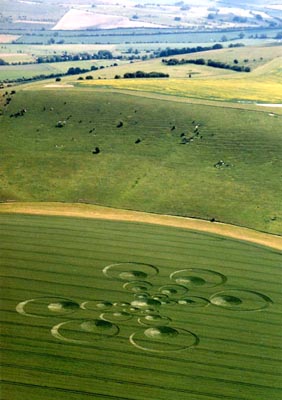
Websites:
http://home.clara.net/lucy pringle
http://www.cropcircleconnector.com
http://www.cropcircleresearch.com
http://www.temporarytemples.co.uk
http://www.invisiblecircle.de and http://www.invisiblecircle.org/ser/d-archiv-2003.html
http://www.busty-taylor.com/cropper/98busty2.htm
© 1998 - 2025 by Linda Moulton Howe.
All Rights Reserved.

